NATIONAL MUSEUM OF AMERICAN HISTORY
Has Someone Else Ever Made a Decision That Affected Your Body?
We asked our visitors to talk back about bodily autonomy, and here’s what they had to say
/https://tf-cmsv2-smithsonianmag-media.s3.amazonaws.com/filer_public/ee/b3/eeb322f9-b775-4178-b9fd-fbb1a715907f/awie_a81_exitwall_final_part1_sm.jpg)
“Has someone else ever made a decision that affected your body?”
This is one of the questions the creators of the exhibition Girlhood (It’s complicated) asked visitors to consider. The exhibition team invited audiences to share their thoughts with each other and with us through handwritten postcards near the end of the show. The exhibition, which opened in October 2020 to commemorate the anniversary of women’s suffrage, focuses on the history of gender roles and the social construction of girlhood from 1800 to the present. The thematic exhibition explores politics, education, work, wellness, and fashion and argues that girlhood is political. Girls and people who identified as female have historically had a political voice, even if they’ve often been overlooked.
The curators of the exhibition chose to focus on girls aged about 10 to 18. We hope that visitors walk away thinking about how girlhood has a history. The meanings of girlhood have never been fixed and Americans have debated those meanings throughout the nation’s history. Indeed, the mission of the National Museum of American History is to empower people to create a just and compassionate future by exploring, preserving, and sharing the complexity of our past. As historians, we don’t want to reconstruct entrenched gender binaries, but rather provoke a thoughtful discussion of gender as having a long and complicated history. There has been a lot of public and private dialogue about girls, their bodies, and what roles they should play in society, as demonstrated for example by the flood of advice literature in the late 1800s and early 1900s. Those conversations, however, have frequently excluded girls’ voices despite how much girls have shaped those debates. We see this community bulletin board as a way to address that exclusion.
Since we debuted the Talk Back cards in the fall of 2021, some 15,000 visitors have shared their thoughts and experiences with us. Their messages have, among other things, interrogated the meaning of “girl power,” delved into the way work shapes girls’ lives, and wrestled with the restrictions of dress codes—all topics that we plan to explore in more detail in future blog posts.
This year, especially since the leak of the draft opinion on Roe v. Wade, visitors have had much to say in response to the question that began this blog: “Has someone else ever made a decision that affected your body?” What visitors, mostly female, have shared is broader than the topic of reproductive rights. Visitors to the exhibition address the many ways in which female bodies, and especially girls’ bodies, are the subject of regulation, surveillance, and criticism. In other words, girls and women have shared the ways in which lots of people, other than themselves, make decisions about their bodies. But they also have shared tactics for talking back, making change, and supporting each other.
In the mix of national discussion about Roe v. Wade (1973) and Dobbs v. Jackson (2022), we’ve seen strong feelings, moving experiences, and a lot of pointed statements about the human right to make health decisions regarding one’s own body. The sidewalk in front of the Supreme Court isn’t the only public venue where people can have a voice and debate the issue. They are also doing it wholeheartedly and honestly at the museum! The National Museum of American History is a non-partisan, public, and safe space to talk about these issues.
What follows is a sampling of the responses. Many of the cards reflect the unruly aesthetic of ’zines (short for community-produced, self-published magazines) with illustrations as their primary form of expression. The Talk Back cards have offered a space for public protest unique to the museum. Unlike on the National Mall, speakers don’t need a permit. Unlike in a newspaper, writers can be any age to express their opinions. Unlike on social media, the museum hosts a broad cross section of visitors sharing the same space. The experiences and ideas shared on the cards are intergenerational. They span ages. Sometimes older people speak directly to younger ones, and vice versa. Sometimes visitors sign the cards with names and ages and social media handles. We’ve redacted last names and social media handles to protect writers’ anonymity and removed expletives on two cards.
Dress codes topped the list of answers to the question. Many girls have been “dress coded.” Americans have regulated, critiqued, and controlled, what girls wear at school, in public, and sometimes at home. We were inspired by a piece by New York Times advice columnist Philip Galanes, who noted the prevalence of dress coding girls in the United States, saying, “I often hear from girls that their parents and schools obsess over what they wear and how they look. Whether this is positioned as minimizing the temptation for boys to behave badly . . . or just commenting nonstop . . . the message is the same—and all wrong: Women’s bodies are community property.”
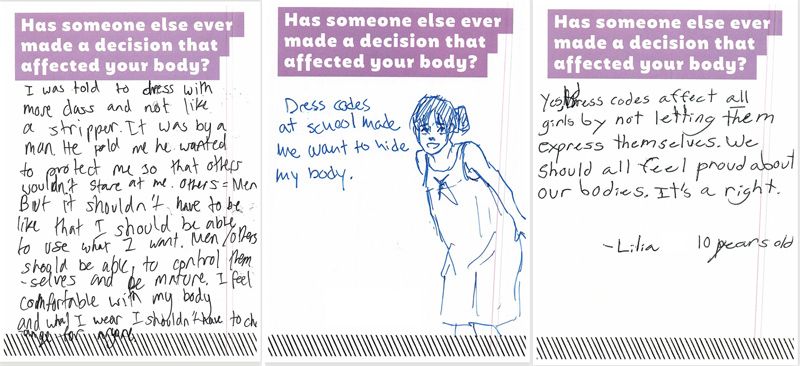
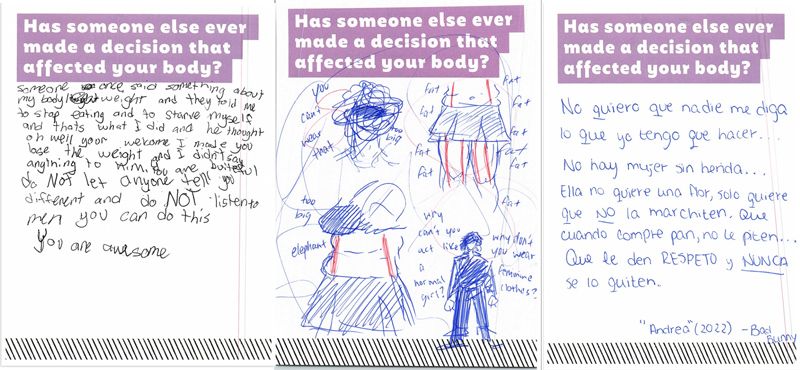
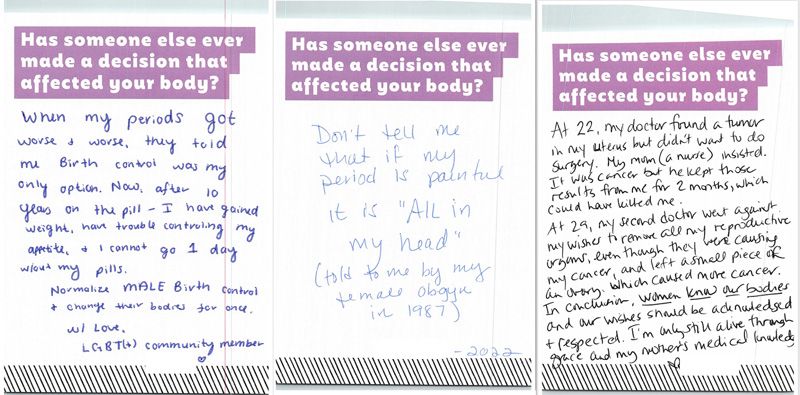
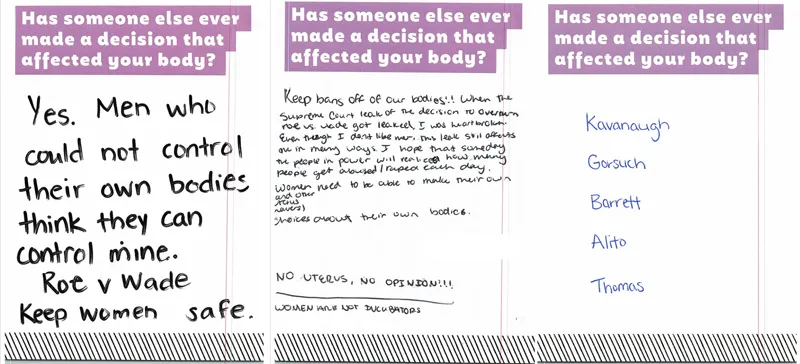
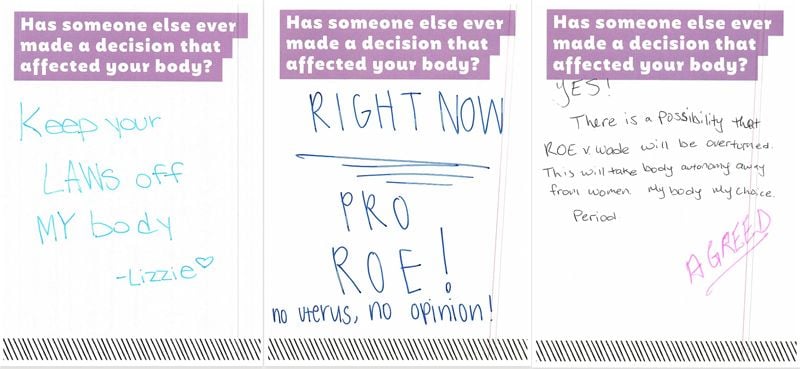
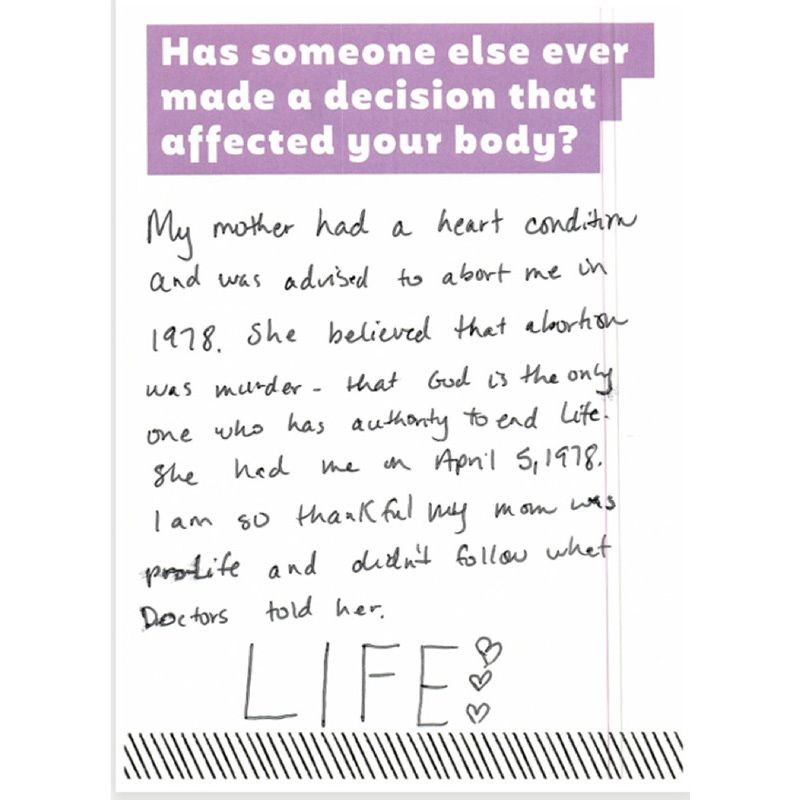
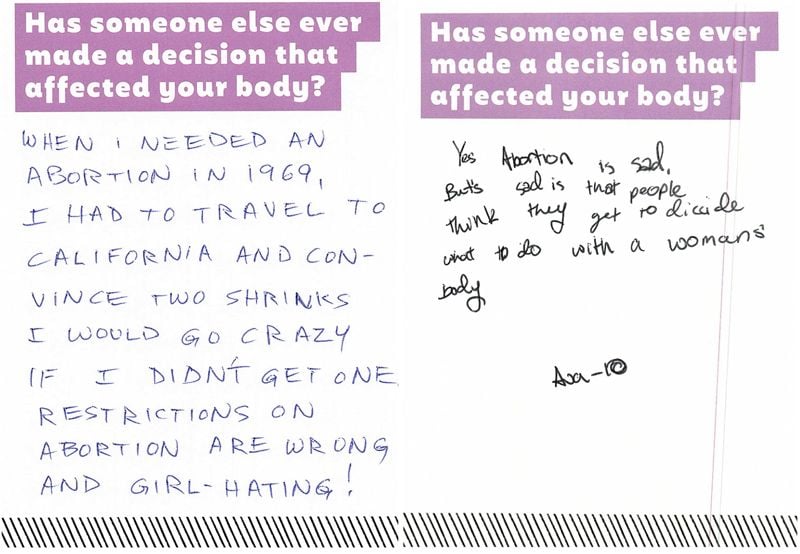
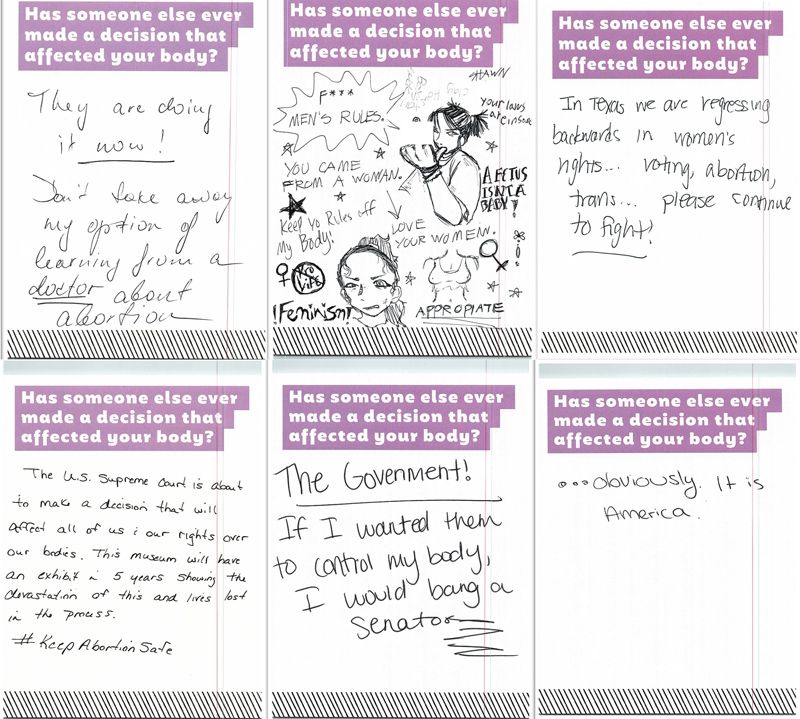
The gallery’s Talk Back section was filled with experiences, protest, and opinions in the months and weeks leading up to the Dobbs decision. Many of those were angry and showed the long history of disrespect for girls and women, and the overload of advice, censorship, and laws that they have had to negotiate.
After the Dobbs v. Jackson decision was handed down on June 24, the Talk Back gallery exploded with a fresh round of comments. The group of 186 cards collected the day or two after the decision revealed a very consistent set of calls to recognize the decision as historic, a monumental overturning of a constitutional right to body autonomy. The people who set pen to paper here were somewhat sad or aggrieved, but overwhelmingly angry and loud. Some encouraged girls to not give up, and to continue to speak up. And while two cards spoke for the unborn, 184 amplified the sentiments below. They tracked closely to national polls that put the majority of Americans on the side of reproductive rights.
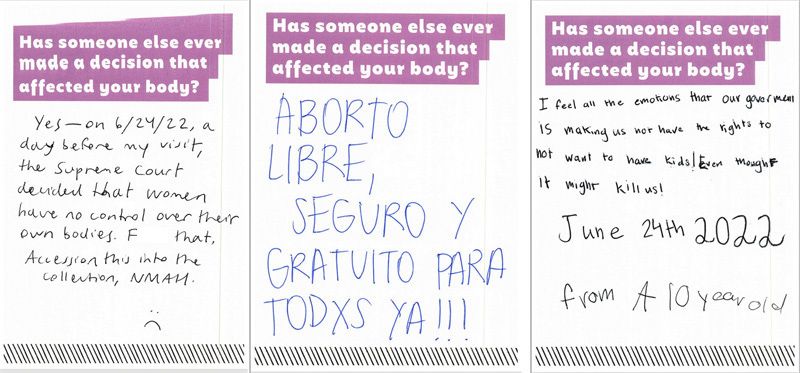
Did these voices make a difference in light of the Dobbs v. Jackson decision? Does it matter what visitors, especially girls, women, those identified as females and their allies say in a museum exhibit at the nation’s history museum? Yes, as the historians who wrote these questions, we’re taking the short and long view. We feel the anger and frustration. We wanted to create a space where people could share their experiences, surrounded by the history of girlhood. We want them to see they are part of a long continuum of debate over women and girls’ bodies, and part of a long history of girl activism. Most importantly, these cards are the writing on the wall of history. They are people asking to be heard. Every time girls raise their voices, they share their personal and political views, which in the case of body autonomy, are often one in the same. We should all listen.
Girlhood (It’s complicated) received support from the Smithsonian American Women’s History Initiative.
This post was originally published on the National Museum of American History's blog on October 26, 2022. Read the original version here.
